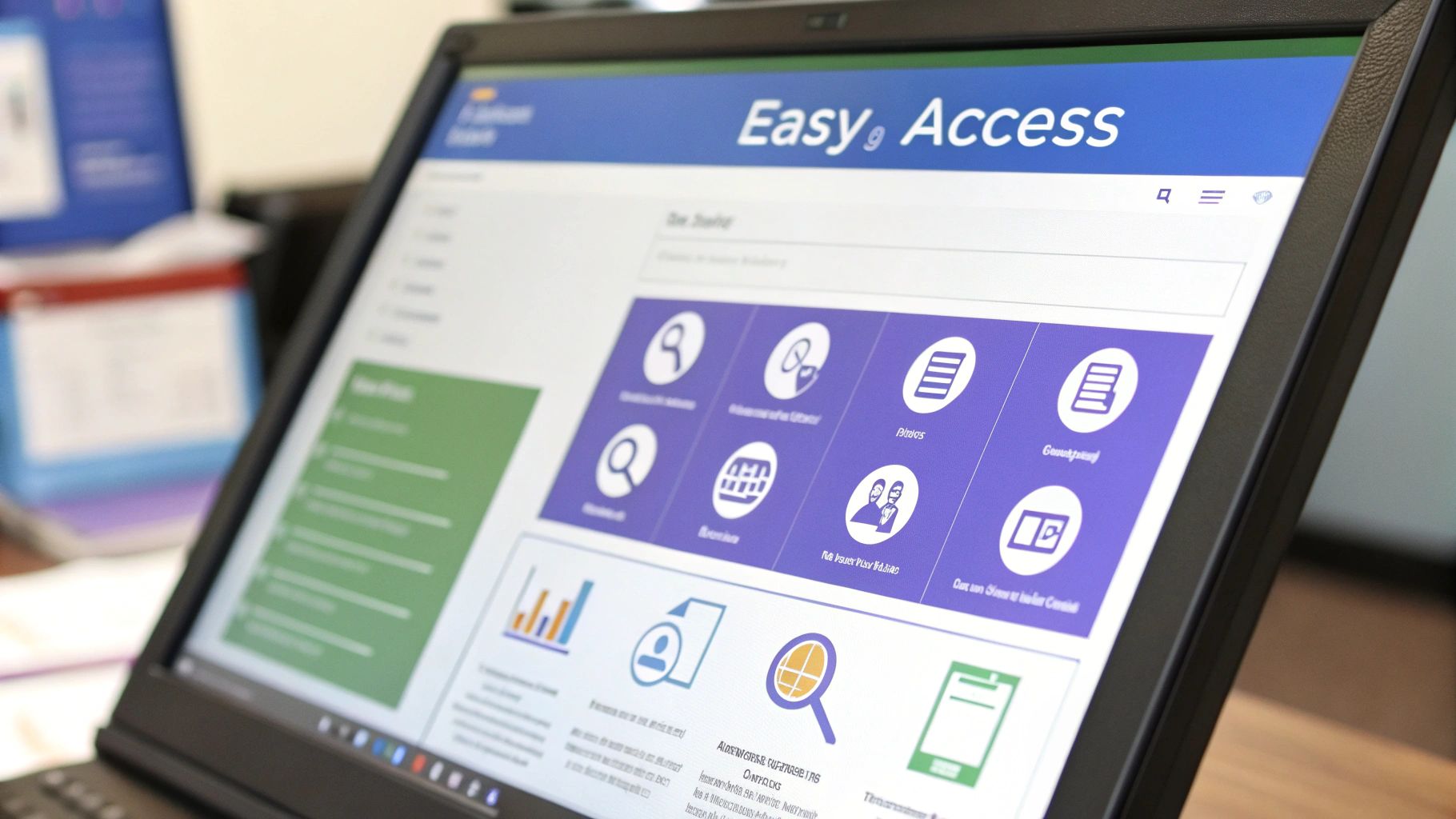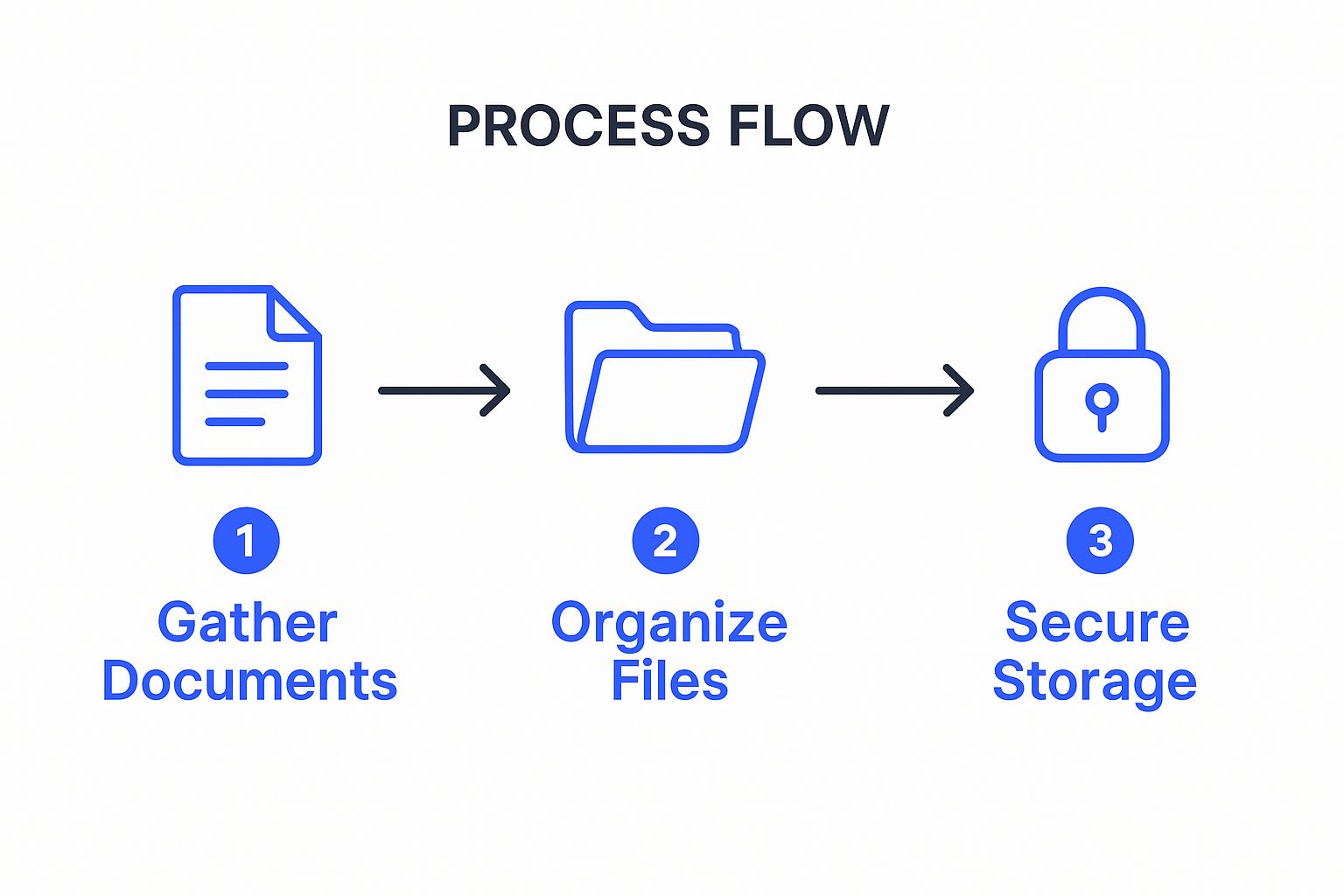
Let's be honest: searching for a lost invoice or a misplaced contract is a frustrating waste of time. For small businesses, this isn't just an annoyance—it's a direct drag on growth and profitability. Effective small business document management means moving past the generic "go paperless" advice and building a strategic system that becomes a secret weapon for agility and client trust.
Why Smart Document Management Is a Game Changer

Too many businesses treat document management as a tedious chore rather than a powerful competitive advantage. The reality is that disorganized files create hidden costs that quietly drain your resources every single day.
When your team spends valuable minutes—or even hours—hunting for information, they aren't focused on what truly matters: serving clients, innovating, and growing the business. This disorganization can lead to missed deadlines, poor customer service, and a general feeling of operational chaos.
The Hidden Costs of Sticking with Paper
It's surprising how many companies still operate with overflowing filing cabinets. Recent data shows that nearly half of small and midsize businesses (45%) continue to rely heavily on paper records. This approach comes with significant drawbacks, from the obvious need for physical storage to the constant risk of misplacing or losing critical records. You can discover more insights about these document management findings and see how your business compares.
This reliance on manual systems directly impacts your bottom line. Think about the time it takes to physically retrieve a file, make a copy, and then refile it correctly. Now multiply that by every employee, every day. It adds up fast.
A well-structured document management system isn't about buying fancy software; it's about reclaiming your team's time and building a foundation for scalable growth. It transforms information from a liability into a valuable asset.
To really see the difference, let’s quickly compare the old way with a modern digital approach. This table breaks down the core differences in a nutshell, showing just how much you stand to gain by making the switch.
Manual vs Digital Document Management at a Glance
| Aspect | Manual (Paper-Based) | Digital (DMS) |
|---|---|---|
| Efficiency | Slow, manual retrieval and filing. Prone to human error. | Instant search and retrieval. Automated workflows. |
| Accessibility | Limited to a physical location. Difficult to share. | Secure access from anywhere. Easy collaboration. |
| Security | Vulnerable to theft, fire, or damage. No access control. | Encrypted and secure. Granular user permissions. |
| Cost | High costs for storage, paper, printing, and staff time. | Lower operational costs. Minimal physical storage needed. |
| Compliance | Difficult to track and manage retention policies and audits. | Automated compliance, retention rules, and audit trails. |
As you can see, a digital system offers clear advantages across the board. It's not just about tidying up; it's a fundamental upgrade to how your business operates.
Moving from Clutter to Control
The goal of effective small business document management is to create a single source of truth where information is secure, accessible, and easy to find. This isn't just about scanning documents and putting them in folders. It's about building a system that:
- Boosts Efficiency: Instantly locate any contract, proposal, or invoice with a simple search.
- Improves Security: Control who can view, edit, or share sensitive information like financial reports or HR files.
- Enhances Collaboration: Allow team members to work on the same document simultaneously without creating conflicting versions.
- Ensures Compliance: Easily manage retention policies and audit trails to meet industry regulations.
By shifting from digital clutter to streamlined control, you set a clear path for a more agile and resilient business.
How to Pinpoint Your Real Document Needs
 Before you even think about shopping for software, let's take a step back. It’s easy to get excited about a new tool, but if it doesn't solve a real, specific problem in your business, it's just a waste of money. Jumping into a solution without a clear diagnosis is a classic misstep I see all the time.
Before you even think about shopping for software, let's take a step back. It’s easy to get excited about a new tool, but if it doesn't solve a real, specific problem in your business, it's just a waste of money. Jumping into a solution without a clear diagnosis is a classic misstep I see all the time.
The best place to begin is by looking at your current process—not some stuffy, formal audit, but a practical look at where things get messy day-to-day. Where does your team get stuck? Is it the slow invoice approvals that are holding up payments? Or maybe the chaotic client onboarding that’s leaving a bad first impression? These are the real issues you need to solve.
Map the Journey of Your Critical Files
To get a truly clear picture, pick a few of your most important documents and follow their entire journey. Think about a client contract or a new hire’s HR file. Who creates it? Who has to review and sign off on it? Where does it live once it's done, and who needs to find it later?
This simple exercise is incredibly revealing. You'll quickly uncover the hidden friction points in your workflows. You might realize a critical contract sits in someone's inbox for days, just waiting for a signature. Or that finding an old invoice means a painful ten-minute search through a disorganized shared drive. These are the exact problems your new small business document management system should be designed to fix.
By tracing these paths, you start to see the real-world costs of being disorganized. For a more detailed walkthrough of this crucial first step, our full guide on document management for small business can help you build a solid foundation.
The goal here is to shift your thinking from a vague "we need to get organized" to a specific "we need a system that cuts our invoice approval time from five days to one and locks down access to all HR files."
Create Your Must-Have Feature Checklist
Once you've pinpointed your biggest headaches, you can translate them into a practical checklist of features. This isn't about finding the flashiest software with every bell and whistle imaginable. It's about matching specific features to your specific problems.
Based on what you found, your checklist might look something like this:
- Powerful Search: If finding files is a major time-waster, you'll want a system with advanced search, maybe even one that can read the text inside scanned documents (often called OCR).
- Version Control: For teams that collaborate on documents, you know the pain of working on an old version. A system that tracks changes and keeps everyone on the same page is a lifesaver.
- Automated Workflows: If approvals are your bottleneck, look for tools that can automatically send a document to the right person, in the right order, without anyone having to chase it down.
- Granular Security: When you handle sensitive information like client financials or employee records, you absolutely need control over who can see, edit, or share each file.
This focused list becomes your blueprint. It keeps you from getting distracted and ensures you invest in a solution that actually makes your life easier, not just another piece of software your team has to learn.
Choosing the Right Tools for Your Business

The software market is packed with options, but finding the right tool for your small business document management doesn't have to be a headache. The trick is to match the tool to where your business is right now in terms of size and complexity, not the other way around.
For a solopreneur or a tiny team just getting started, a familiar cloud storage solution might be all you need. I'm talking about tools like Google Drive or Dropbox, but used with real intention. When you pair them with a strict folder structure and clear file-naming rules, they can be surprisingly effective for basic organization and sharing.
But as your business grows, your needs get more complicated. You'll quickly hit a wall where simple cloud storage just doesn't cut it anymore—especially when you need to manage different document versions or create approval workflows. That’s when dedicated Document Management Systems (DMS) enter the picture.
When to Graduate to a True DMS
So, how do you know it's time to make the jump? Look for these tell-tale signs: you're struggling to track changes on collaborative files, you suddenly need an audit trail for compliance, or your team is wasting precious time manually sending documents around for signatures. A real DMS is built to automate these headaches and lock down your security.
Think about a growing marketing agency that’s juggling dozens of client contracts and creative briefs. They have to make sure designers are always working on the latest version and that every contract gets reviewed by the right people before it goes out. Simple cloud storage can't enforce that kind of process. A DMS can.
The right tool shouldn't just store your files; it should actively support your business operations. Its job is to reduce friction and make your workflows smoother, not add another layer of complexity.
Core Features That Deliver Real Value
It's easy to get mesmerized by long lists of features when comparing tools. My advice? Zero in on the ones that will actually make a difference in your team's day-to-day work. Here are the essentials I always tell people to look for:
Powerful Search: Look for Optical Character Recognition (OCR). This game-changing feature allows the system to “read” the text inside scanned documents and images. It means you can find a specific invoice number from a scanned PDF, not just from the file name. It’s a lifesaver.
Seamless Integrations: Your DMS shouldn't be an island. Check for native integrations with the software you already depend on, like QuickBooks for accounting, Salesforce for your customer data, or Slack for team chat.
Rock-Solid Security: This is absolutely non-negotiable. Look for features like user-based permissions, which let you control exactly who can view, edit, or delete certain files or folders. This is critical for protecting sensitive information, like HR records or financial data.
The move toward better security and cloud-based systems is driving massive growth in this market. Valued at around $8.96 billion in 2024, the global document management system market is projected to nearly double to $17.03 billion by 2029. This boom is largely fueled by small and medium-sized businesses finally getting on board. You can read the full research about DMS market growth to see where things are headed.
Picking a tool that can grow with you isn't just a purchase; it's one of the smartest investments you can make for your company's future.
Designing Your Digital Filing Cabinet
So you've picked out a great document management tool. Fantastic. But here’s the thing—a powerful system without a logical structure is just a fancy, expensive junk drawer. All that valuable information is in there somewhere, but good luck finding it. This is where you build the intuitive framework that actually makes your entire small business document management strategy work.
The goal is simple: create a digital filing cabinet so clear and consistent that a brand new team member could find a specific invoice from two years ago without asking anyone for help. This all starts with a smart folder structure.
Building Your Core Folder Structure
First, think big. What are the main pillars of your business? Most small businesses can organize pretty much everything under a few main parent folders. This creates a high-level map that anyone can understand at a glance.
Here are the usual suspects for top-level folders:
- Administration: For all the internal company stuff—policies, handbooks, and operational files.
- Clients: The dedicated home for every piece of client-related work.
- Finance: If it has to do with money, it lives here. Think invoices, receipts, and expense reports.
- Human Resources: A secure, access-controlled space for all employee files and HR-related documents.
- Marketing: The go-to folder for branding assets, campaign materials, and all things promotional.
- Legal: A crucial folder for contracts, NDAs, and other corporate documents.
Once you have these established, you can start creating subfolders that drill down logically. For example, a file path for a client project might look something like Clients > [Client Name] > [Project Name] > Proposals. The beauty of this is that it's predictable and it grows with your business.
Establishing Clear File Naming Rules
A consistent file naming system is the secret sauce to making your documents searchable. Without one, you're doomed to sift through a chaotic mess of files like Invoice.pdf, Final_Invoice_v2.pdf, and ClientInvoice_Dec.pdf. A simple, mandatory rule can fix this chaos almost overnight.
A fantastic format to start with is YYYY-MM-DD_DocumentType_Description. Why? Because it automatically sorts files chronologically and tells you exactly what a file is just by looking at the name.
A disciplined file naming system does more than just organize your folders; it fundamentally changes how you search. You stop guessing and start finding documents with precision, saving countless minutes every single day.
Let's look at a few templates you can steal and adapt for your own business. It's a small change, but the impact on your team's day-to-day efficiency is massive.
Sample File Naming Convention Templates
These templates offer a straightforward, copy-paste-ready way to bring consistency to your file naming. Adopting a clear standard like this makes documents much easier to find and manage across all your business functions.
| Document Type | Recommended Naming Convention | Example |
|---|---|---|
| Invoice | YYYY-MM-DD_INV[Invoice#]_[ClientName] | 2024-10-26_INV1045_AcmeCorp.pdf |
| Contract | YYYY-MM-DD_Contract_[PartyName]_[Project] | 2024-11-05_Contract_InnovateLLC_WebsiteRedesign.docx |
| Meeting Notes | YYYY-MM-DD_Minutes_[MeetingTopic] | 2024-11-15_Minutes_Q4-Planning.pdf |
| Expense Report | YYYY-MM_ExpenseReport_[EmployeeName] | 2024-10_ExpenseReport_JaneDoe.xlsx |
Implementing these simple rules will make your digital files far more organized and searchable, which is a huge win for productivity.
Unlocking the Power of Metadata and Tags
Folders and file names are just the start. The real magic of a modern document system lies in metadata—the data about your data. Think of it as adding smart, searchable "sticky notes" to every single file.
While a folder tells you where a document is, tags and metadata tell you what it is. You can add tags like Q4-Report, Active-Contract, or Requires-Signature. This lets you find every document related to a specific project or status, no matter where it's stored in your folder structure.
For example, imagine you need to see every active contract across all your clients. Instead of digging through dozens of folders, you could just search for the "Active-Contract" tag and pull them all up instantly. This is where organization gets really powerful. Our guide on how to automate your document workflow digs deeper into how you can use these tags to trigger actions, like sending renewal reminders for contracts. This is how you transform a static digital filing cabinet into an active, intelligent system that works for you.
Building Workflows That Run Themselves
Having an organized digital filing cabinet is a great start, but the real magic happens when you make that system work for you. It’s time to stop thinking of your digital storage as a passive shoebox for files and start treating it as an active, intelligent part of your business operations. The way to do that? Automated workflows.
Imagine a new client contract hits the designated folder. Instead of you having to remember to email your business partner, the system automatically pings them for review. Or picture an invoice that, once saved, routes itself directly to your bookkeeper for approval—no extra steps on your part. That’s the goal: a system that enforces your business rules so you don’t have to.
Automating Common Business Tasks
Most document management software—and even some of the more advanced cloud storage platforms—gives you the power to create simple “if this, then that” rules. You can set up triggers based on what a document is, keywords in its file name, or where it’s saved.
For example, a photography studio could build a workflow where any file tagged with "Client-Proof" is instantly moved to a shared folder accessible only to that specific client. This single rule eliminates the mind-numbing task of manually creating and sharing folders for every gallery, slashing both errors and wasted hours.
Workflows turn your document system from a place where files go to die into a dynamic tool that actively moves your projects forward. It’s about building a process that runs itself, giving you more time to focus on strategic work.
This visual flow shows the foundational steps for getting your documents ready for a system like this—gathering, organizing, and securing them.

Think of these as prerequisites. Without well-organized and secure files, any workflow you try to build will be on shaky ground.
Locking Down Security With User Permissions
Automation isn't just about moving files around to be more efficient; it's also a powerful tool for security and compliance. One of the most critical workflows you can set up is managing who can see and touch sensitive information. Your document management system should let you set granular user permissions.
This means you get to be the gatekeeper, specifying exactly who can view, edit, share, or delete certain files. For instance:
- HR Files: Only you and your HR manager can access the 'Human Resources' folder. For everyone else, it’s invisible.
- Financial Records: Your accountant gets the keys to the 'Finance' folder, but your sales team is locked out completely.
- Client Contracts: A project manager might be able to view and comment on a contract, but only a company partner has the permission to approve the final version.
Setting up these roles is a one-and-done task that pays dividends forever. It prevents accidental deletions, keeps confidential data from falling into the wrong hands, and creates a clear audit trail showing who did what and when.
This level of control is especially vital for legal documents. For a deeper look into this specific area, you can learn more about dedicated small business contract management and how to apply these principles to your agreements. By automating permissions, you build a secure framework that protects your business from the inside out.
Your Questions on Document Management Answered
It’s completely normal to have a few final questions before diving into a new system for your business. Concerns about cost, how long it’ll take, and where to even begin are things I hear all the time from other small business owners.
Let's clear up some of that confusion. My goal here is to give you direct, no-fluff answers to help you move forward with confidence.
How Much Should This Actually Cost?
This is the big one, and the honest answer is: it really depends on what you need.
A solo freelance photographer might get by perfectly with an advanced cloud storage plan for as little as $15 per month. But a growing 15-person consulting firm needing automated workflows and tighter security might look at a true Document Management System (DMS) costing anywhere from $200 to $400 per month.
The cost is directly tied to the headaches you're trying to fix. Instead of getting hung up on the price tag, think about the return on your investment. If a $300/month system saves your team 20 hours of administrative work every month, it’s already paying for itself several times over.
What Is the Very First Actionable Step I Should Take?
Don't go shopping for software. Not yet.
The most important first step is to do a quick, informal audit of your current document pains. For one week, grab a notebook and jot down every single time you or someone on your team gets frustrated trying to find, share, or manage a file.
- Did it take 10 minutes to dig up a tax receipt from last year? Write it down.
- Did two people accidentally work on different versions of the same client proposal? Write it down.
- Was a contract held up because it was buried in someone's inbox? Write it down.
After a week, you'll have a real-world list of problems that need solving. That list is your roadmap. It ensures you pick a solution that fixes your actual business issues, not just one with a bunch of flashy features on a sales page.
How Long Does It Take to Get a New System Up and Running?
The timeline really depends on the complexity. For a basic setup using enhanced cloud storage, you could be fully up and running in a single weekend. That mostly involves creating your new folder structure and teaching your team the new file naming rules.
A more powerful DMS, however, is a bigger project. For a small business, a realistic timeline is usually between two to six weeks. Here’s a rough breakdown of what that looks like:
- Planning and Design: Figuring out your folder structures and workflows (1-2 weeks).
- Configuration and Setup: Customizing the software to fit your process (1 week).
- Data Migration: Moving all your existing files into the new system (1-2 weeks, depending on how much you have).
- Team Training: Getting everyone comfortable and proficient with the new tools (1 week).
The biggest mistake I see is rushing the migration and training phases. A phased rollout—maybe department by department—is almost always smoother than a "big bang" launch. Take the time to get it right from the start to avoid headaches and pushback later.
This structured approach to small business document management leads to a much smoother transition and gets your team on board, making the whole investment truly worth it.
Navigating the complexities of legal documents is a critical part of managing your business files. With Legal Document Simplifier, you can instantly understand complex contracts, leases, and NDAs. Our AI-powered platform extracts key terms, dates, and obligations, turning dense legal jargon into clear, actionable summaries. Stop guessing and start making confident, informed decisions.
Learn how Legal Document Simplifier can protect your business today.